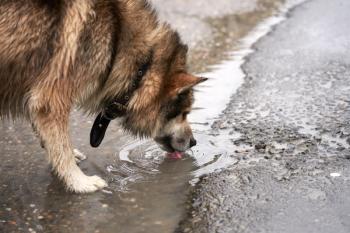
Infectious disease control in the shelter environment (Proceedings)
Between 6 and 8 million dogs and cats are admitted to animal shelters each year in the United States. Often the animals admitted are unvaccinated, undernourished, stressed, and carrying one or more diseases.
Between 6 and 8 million dogs and cats are admitted to animal shelters each year in the United States. Often the animals admitted are unvaccinated, undernourished, stressed, and carrying one or more diseases. Infection disease control should be an essential component of the care of any animal admitted to a shelter. Every shelter should have an infection control plan consisting of: appropriate vaccination practices, effective cleaning and disinfection protocols, and functional shelter policies and procedures related to animal movement, staff movement and animal isolation. Each of these will be addressed in this paper.
Risk factors for infectious disease in animal shelters
There are many potential factors that put animals in shelters at risk for infectious disease. These include overcrowding, stress, lack of vaccinations, poor nutritional status, poor sanitation, and introduction of diseased animals. Disease control programs must be designed to address each of these factors.
Principles of infection control
Infection control plans should include the hygienic practices of shelter staff, cleaning and disinfection protocols, handling of infectious waste, basic animal examination and screening, vaccination practices, parasite control, routine testing for disease and isolation. Additional features of a plan should deal with facility design especially related to isolation, quarantine, temperature control and ventilation.
Hygienic practices of shelter staff
Hand washing and use of hand sanitizers are a vital component to any disease control plan. Hands often serve as fomites and handling multiple animals without washing or sanitizing hands can rapidly spread disease through a shelter. All staff that handle animals should wash or sanitize hands after handling each animal. They should never go from one animal to the next without washing or sanitizing their hands.
Cleaning and disinfection protocols
Cleaning and disinfection is another essential element in minimizing disease in a shelter. Proper cleaning and disinfection protocols significantly reduce transmission of disease pathogens. The key here is proper cleaning and disinfection. Commonly shelters use inappropriate and highly ineffective methods of cleaning and disinfecting animal housing facilities and other objects within the shelter.
Cleaning practices in shelters are often ineffective and sometimes dangerous. Inappropriate practices include spraying runs or other outdoor enclosures with water without removing organic debris first and, unfortunately, without remove the animal(s) before spaying. Simply hosing down a run without first removing organic debris, aerosolizes the organic material and potentially spreads disease throughout the facility. Leaving the animal in the enclosure while doing this increases stress, makes the animal wet and dirty, and increases susceptibility to disease. Simply spraying a cage with disinfectant, immediately wiping down the surfaces and returning the animal is also ineffective. Many disinfectants are inactivated by organic material and most require that the disinfectant be present for a specific length of time to be effective. Cages, counter tops, exam tables, food and water bowls etc. must be cleaned prior to disinfection and the disinfection must be left on the surface for the appropriate (read label instructions) contact time.
Not all disinfectants are alike and disinfectants that will be effective in the specific environment where they will be used must be selected and used appropriately. The most commonly used disinfectants are bleach and quaternary ammonium compounds (Roccal®, Kennel-sol®, Parvo-sol®). Bleach is effective if used properly, but is inactivated by organic material and by light. Storage of bleach in proper containers that prevent passage of light and proper cleaning to remove all debris, especially organic debris, is essential for bleach to be effective. The ideal bleach solution is a 1:32 dilution. Anything more concentrated can be harmful to mucous membranes and, therefore, may actually cause increased incidence of infectious disease. Quaternary ammonium compounds are also inactivated by organic debris and only have limited effect on parvovirus, panleukopenia, calicivirus and ringworm; all very common and highly contagious infectious diseases in the shelter environment.
Not all disinfectants are safe for use in animals and staff must take precautions for their own safety. Phenolic disinfectants (Lysol®) are toxic to cats, for example. Personnel mixing or using disinfectants should wear gloves and should read and follow label instructions.
A proper cleaning and disinfection protocol as described in "Maddies Infection Control Manual for Animal Shelters" consists of:
1. Removing all visible debris,
2. Washing the area or object with soap/detergent and water,
3. Rinsing the area or object to remove any detergent residue,
4. Allowing the area to dry,
5. Apply an appropriate disinfectant,
6. Leaving the disinfectant in place for the appropriate contact time,
7. Rinsing away any residual disinfectant, and
8. Allowing the area to dry once again.
Only after a thorough cleaning and disinfection as described should animals be put back in the enclosure.
Cleaning order is also very important. Cleaning should proceed from the youngest, cleanest, most susceptible animals and proceed to the older, least susceptible animals. Dirty areas or areas with animals with infectious disease should be cleaned last. A recommend flow, in order, is:
1. Adoptable puppies and kittens,
2. Adoptable adults,
3. Stray healthy puppies and kittens,
4. Stray healthy adults,
5. Isolation area,
6. Quarantine area,
Ideally each area would have its own cleaning and disinfection equipment and supplies to prevent the cleaning materials themselves from serving as fomites.
Handling of infectious waste
Infectious waste, if not handled and disposed of appropriately, leads to spread of disease throughout a facility. Waste should be bagged in the area where it was generated and rebagged once it is taken outside that area. It must be then stored in an area or container that prevents other animals getting into the waste material.
Basic examination and screening
All animals entering a shelter should be examined. Ideally a veterinarian would perform the examinations, but that might not always be possible. In the absence of a veterinarian a trained veterinary technician should perform these examinations. The physical examinations should be performed as soon as possible after admission to the shelter and before the animal is mixed with any population of animals. Results of the physical examination should be used to determine if the animal is immediately euthanized (severe injury or disease), placed in quarantine (minor disease), or placed in isolation (no obvious signs of disease). No animal admitted to the shelter should be immediately placed in the adoptable population as this puts all adoptable animals at potential risk if the animal is incubating a disease.
Routine testing for disease
Shelters should routinely test dogs for heartworms and cats for FeLV and FIV. Each shelter should have specific policies detailing disposition of heartworm positive dogs and FeLV or FIV positive cats.
Vaccination practices
All animals admitted to the shelter, except those placed in quarantine due to disease should be vaccinated. Dogs should receive vaccines against distemper, hepatitis, parainfluenza, parvovirus, rabies and kennel cough. Cats should be vaccinated against rhinotracheitis, calicivirus, panleukopenia and rabies.
Parasite control
Internal and external parasites should be treated. A good routine is for all animals admitted to the shelter to be treated with pyrantel pamoate for roundworms and hookworms. If possible fecal examinations should be performed to detect whipworms, tapeworms and coccidia. Infested animals should be treated. Animals with external parasites should be treated.
Temperature control and ventilation
Appropriate ventilation is a key factor in reducing airborne diseases. Ideally ventilation will allow 15 air exchanges per hour. While this is expensive, it is critical for reducing incidence of disease. Temperature control is also an essential component to maintaining healthy animals. Animals placed in environments that are too cold or too hot become stressed and more susceptible to disease.
Conclusions
There is no one infectious disease protocol that is appropriate for all shelters. Each shelter must establish their own protocol individualized to their unique situation. However, lack of funds should not be an excuse for avoiding the development and use of infectious disease control protocols. Lack of funds may significantly reduce the numbers of animals that can be safely housed in a shelter in a manner that reduces disease and suffering, but the variable should be the number of animals housed, not the level of care given to each animal.
Newsletter
From exam room tips to practice management insights, get trusted veterinary news delivered straight to your inbox—subscribe to dvm360.




